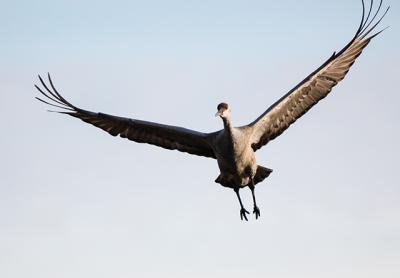Nature Notes: A Sandhill in Wainscott

Every once in a while a bird shows up that takes the South Fork by storm. In the past, it’s been eagles, snowy owls, pelicans, Lapland longspurs, Ross’s gulls, puffins, painted buntings, and scissor-tail flycatchers, to name but a few. Birdwatchers come from all over the United States, even from as far west as California, to see some of those rare birds.
Another has shown up recently. This one stands up to four feet tall, has a long pointy bill and a red patch on the back of its head. Its wingspan can be six feet from tip to tip when fully extended. It soars like a vulture for hours on end and is often confused with herons and egrets. You probably guessed it: It is the sandhill crane, Grus Canadensis. “Grus” because of the growling trumpet-like calls it makes, “canadensis” because the majority of the migrating ones breed on the sand hill prairies of western and central Canada.
It is not the first one to be seen on the South Fork or the rest of Long Island. Several decades ago, one was spotted by a boy in Bridgehampton. Because he was a young, novice bird watcher, his sighting had to be confirmed by a senior bird watcher, one with more experience and authority.
That boy, Alex Van Boer, is now grown and married and does professionally what he used to do for fun: He works for Colorado’s Bird Conservancy. He is the son of the late landscape photographer and portraitist Diane Gorodnitzki. Diane was a longtime ecological contributor to various South Fork conservation groups including the Group for America’s South Fork (now Group for the East End) and the Peconic Land Trust. She died in 2010, a great loss to eastern Long Island, its pastoral fields, and its fauna and flora. His father, Kenton Van Boer, is an architect who practiced his art here, but now resides in Maine.
I don’t get around as much as I used to and I would never have heard about the crane if it were not for a call from Elizabeth Sarfaty, who in turn got a call from a friend who had seen it in Wainscott, south of Main Street, across from the Wainscott Chapel. Elizabeth then put Terry Sullivan on to it and Terry went down and took several photos. In documenting a rare bird, a photo is as valuable as a page-long description. Photos usually do not lie.
Sandhill cranes are not nearly as rare as their larger North American cousin, the gravely endangered whooping crane. There are more than 400,000 of the migratory ones that breed on the upper prairies of the western United State and Canada. Separate non-migratory subspecies can be found in Florida, coastal Mississippi, and Cuba. By far the rarest of the three are those in Cuba, which number about 300 at last count.
Unlike herons and egrets, they don’t fly with their neck crooked, but with their necks straight out ahead and legs straight out behind. They walk or run in the matter of the flightless ratites — ostriches, emus, and such. The migratory ones are mostly herbivorous, stopping to feed in the grain fields of the Southwest, including California, but other populations have more cosmopolitan tastes, even taking mice, frogs, and lizards.
They in turn are prey for a variety of carnivores, including bobcats, mountain lions, coyotes, foxes, raccoons, and even eagles and the larger hawks. Adults defend themselves by running or remaining and fighting, striking with their sharp beaks or kicking with their long sturdy legs in the manner of roosters.
Courtship consists of male and female standing close to each other, facing each other, and making those growling bugle calls back and forth, the male uttering one, the female two back during each round. Hmm, not so different from Homo sapiens couples’ exchange of calls. Males share in the housekeeping with their mates, helping to construct and guard the nest, even sharing the incubation duties. The female lays mostly two-egg clutches. The young, after fledging, stay with their parents until the next brood, after which they hang around in teenage gangs.
Migratory sandhill cranes all occupy eastern Siberia. When they are migrating, cranes mostly ride with the wind and on uplifting currents the way vultures do. These cranes have a very well described fossil record, with ones in North America almost identical to contemporary ones and those dating back two million years or more. No variation of a human has been around that long, so maybe we can learn something from a bipedal bird that is almost as tall as we are, is as monogamous as many of us are, and has a much longer earthly existence.
Larry Penny can be reached via email at [email protected].
